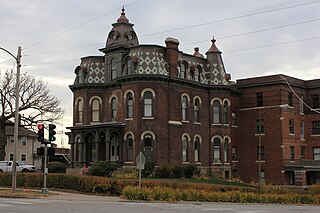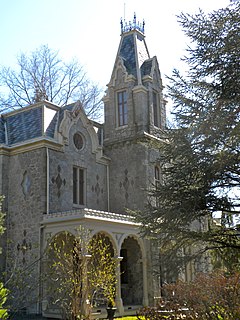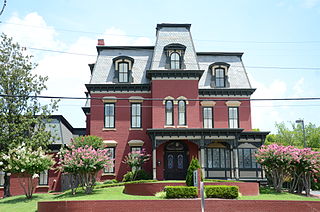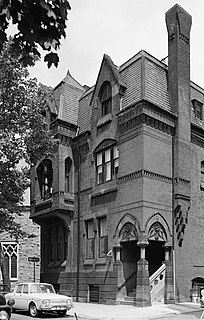
The Ellwood House was built as a private home by barbed wire entrepreneur Isaac Ellwood in 1879. It is located on First Street in DeKalb, Illinois, United States, in DeKalb County. The Victorian style home, designed by George O. Garnsey, underwent remodeling in 1898-1899 and 1911. The house was originally part of 1,000 acres (4 km²) which included a large stable complex known as "Ellwood Green." Isaac Ellwood lived here until 1910 when he passed the estate to his son, Perry Ellwood.

The Noble County Sheriff's House and Jail, also known as the Old Jail Museum, is a historic jail and residence located in Albion, Noble County, Indiana. It was built in 1875 by Thomas J. Tolan and Son, Architects of Fort Wayne, Indiana. It is a 2 1/2-story, red brick building with combined Second Empire and Gothic Revival style design elements. It features round-arched windows, a three-story projecting entrance tower, and a mansard roof.

The Merchants Avenue Historic District in a residential neighborhood southeast of the downtown in Fort Atkinson, Wisconsin, composed of 33 mostly large homes on large lots within six city blocks around Merchants Avenue. It was placed on the United States National Register of Historic Places in 1986.

The Joel N. Cornish House is located at 1404 South 10th Street in South Omaha, Nebraska. The 1886 construction is considered an "excellent example of the French Second Empire style." The house was converted into apartments after the Cornish family moved out in 1911.

Riversdale, is a five-part, large-scale late Georgian mansion with superior Federal interior, built between 1801 and 1807. Also known as Baltimore House, Calvert Mansion or Riversdale Mansion, it is located at 4811 Riverdale Road in Riverdale Park, Maryland, and is open to the public as a museum.

The Clayton-Cedarmere Estates are located in Roslyn Harbor, New York, United States, listed jointly on the National Register of Historic Places in 1986. Clayton, the bulk of the property, is the large landscaped Bryce/Frick estate, now home to the Nassau County Museum of Art. Cedarmere, the smaller of the two, is William Cullen Bryant's estate, currently undergoing interior renovation, is located on the west side of Bryant Avenue; overlooking Hempstead Harbor, now a historic house museum. The grounds are open to the public. The two combined properties, with input from several notable architects, illustrate the development of estates on the North Shore of Long Island over a period of nearly a century.

Rose Hill Manor, now known as Rose Hill Manor Park & Children's Museum, is a historic home located at Frederick, Frederick County, Maryland. It is a 2 1⁄2-story brick house. A notable feature is the large two-story pedimented portico supported by fluted Doric columns on the first floor and Ionic columns on the balustraded second floor. It was the retirement home of Thomas Johnson (1732–1819), the first elected Governor of the State of Maryland and Associate Justice of the United States Supreme Court. It was built in the mid-1790s by his daughter and son-in-law.

The William V. N. Barlow House is on South Clinton Street in Albion, New York, United States. It is a brick building erected in the 1870s in an eclectic mix of contemporary architectural styles, including Second Empire, Italianate, and Queen Anne. Its interior features highly intricate Eastlake style woodwork.

The house at 184 Albany Avenue in Kingston, New York, United States, is a frame building in the Picturesque mode of the Gothic Revival architectural style. It was built around 1860.

The Ebenezer Maxwell House, operated today as the Ebenezer Maxwell Mansion, is an historic house located in the West Germantown neighborhood of Philadelphia, Pennsylvania.

The Dodge Mansion, also known as Turner-Dodge House, is a historic house in Lansing, Michigan that was built in 1855. It was listed on the National Register of Historic Places (NRHP) in 1972 as Dodge Mansion.

The Grove, also known as Loretto Rest, is a historic house located on Grove Court in Cold Spring, New York, United States. It was built as the estate of Frederick Lente, surgeon at the nearby West Point Foundry and later a founder of the American Academy of Medicine, in the mid-19th century. The Italian-villa design, popular at the time, was by the prominent architect Richard Upjohn. In 2008 it was listed on the National Register of Historic Places.

The North Grove Street Historic District is located along the north end of that street in Tarrytown, New York, United States. It consists of five mid-19th century residences, on both sides of the street, and a carriage barn. In 1979 it was listed on the National Register of Historic Places.

The Jonesborough Historic District is a historic district in Jonesborough, Tennessee, that was listed on the National Register of Historic Places as Jonesboro Historic District in 1969.

The McDonald–Wait–Newton House is a historic house at 1406 Cantrell Road in Little Rock, Arkansas. It is a 2-1/2 story brick building, with a mansard roof providing a full third story. The main facade is five bays wide, with a projecting central section topped by a mansarded tower. The roof is pierced by dormers with segmented-arch tops, and windows framed by decorative hoods. The main entrance is set in the base of the tower, with an elliptical stained glass light above. A porch shelters the entrance and wraps around to the right side, with a modillioned cornice and bracketed posts. Built in 1869, it is the last surviving post-Civil War mansion built along what became known as "Carpetbaggers' Row", as it is where a number of Northerners settled when moving to the city.

Church House, also known as the Barrow House, is a historic mansion in Columbia, Tennessee. It was listed on the National Register of Historic Places in 1978.

The Harvey M. Vaile Mansion is located at 1500 North Liberty Street in Independence, Missouri. Built in 1881 for businessman Harvey M. Vaile, it is a locally significant example of Second Empire architecture. The house was listed on the National Register of Historic Places in 1969 and designated locally in 2002; it is open to the public as a museum.

Frederick Krause Mini Mansion, also known as the Ben Ferrel Platte County Museum, is a historic mansion located at Platte City, Platte County, Missouri. It was built in 1882-1883 by Frederic Krause, an immigrant from Prussia. The mini mansion is a two-story, modified "T"-plan, Second Empire style red brick building with limestone corner quoins and foundation. It is topped by a mansard roof with gray-blue and rose hexagonal slate. The roof and porches are crested with ornamental cast iron work. The home is referred to as a 'mini' mansion because it shares several architectural features with the Missouri Governor's Mansion built in 1871. An interior, bronze fireplace surround also represents similar design to the white marble one found in the Governor's Mansion in Jefferson City. The Krause mini mansion houses the Ben Ferrel Museum and genealogical and historical research room for the Platte County Historical Society known by the acronym PCHS. The Platte County Historical Society owns and operates the building which opened to the public in 1985. The museum's collection presents regional history with furnishings and items donated entirely from local families and dating mainly from the mid 1800s to 1920. The museum features exhibits and other special events related to local history and the mini mansion's history.

The Thomas Hockley House (1875) is a Victorian city house in Philadelphia, Pennsylvania, designed by architect Frank Furness. Located west of Rittenhouse Square, it is a contributing property in the Walnut–Chancellor Historic District.

The Southwest Side Historic District is a neighborhood in Stoughton, Wisconsin with over 100 contributing properties in various styles built as early as 1856. It was added to the State and the National Register of Historic Places in 1997.






















